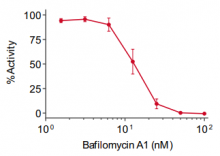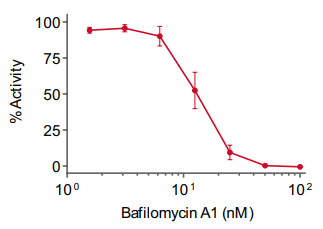Bafilomycin A1
| Product | Unit size | Cat. code | Docs. | Qty. | Price | |
|---|---|---|---|---|---|---|
|
Bafilomycin A1 V-ATPase inhibitor - InvitroFit™ |
Show product |
10 µg 10 x 10 µg |
tlrl-baf1
|
|
Endosomal acidification and autophagy inhibitor

V-ATPase and autophagosome-lysosome fusion inhibition
Bafilomycin A1 (BafA1), a macrolide antibiotic isolated from Streptomyces species, is a specific vacuolar H+ ATPase (V-ATPase) inhibitor. Notably, due to its ability to specifically target V-ATPase and hence disrupt autophagic flux, BafA1 is frequently used to study autophagy and endosomal acidification. Autophagy is one of the three principal mechanisms used by cells to sequester, remove and recycle waste, the others being proteasomal degradation and phagocytosis. BafA1 suppresses the growth of a variety of cancer cells by inhibiting autophagy and inducing apoptotic cell death via various mechanisms [1, 2]. Inhibition of autophagy by BafA1, in combination with anti-cancer therapies (e.g. chemotherapy), represents a promising therapeutic approach that is currently being tested in clinical trials [1].
Mode of action:
By inhibiting V-ATPase, BafA1 prevents the maturation of autophagic vacuoles by inhibiting late-stage fusion between autophagosomes and lysosomes as well as lysosomal degradation [3]. V-ATPases establish and maintain a low luminal pH in endocytic and exocytic compartments. Upon binding to the V-ATPase complex BafA1 inhibits H+ translocation, thereby depriving acidic intracellular compartments (i.e. endosomes, lysosomes, and vesicles) of H+ ions, increasing their pH and inhibiting the function of resident hydrolases. On the other hand, this causes an accumulation of H+ in the cytoplasm of treated cells, leading to acidosis and thus, can cause secondary adverse effects in normal cells [1].
Key features:
- Specific and potent V-ATPase inhibitor frequently used to study autophagy
- InvitroFit™ grade: highly pure (> 90%) and inhibitory function validated in cellular assays
Bafilomycin A1 provided by InvivoGen is for research use only.
![]() Read our review on Autophagy and Innate Immunity
Read our review on Autophagy and Innate Immunity
References
1. Yan, Y. et al. 2016. Bafilomycin A1 induces caspase-independent cell death in hepatocellular carcinoma cells via targeting of autophagy and MAPK pathways. Sci Rep 6, 37052.
2. Yuan, N. et al. 2015. Bafilomycin A1 targets both autophagy and apoptosis pathways in pediatric B-cell acute lymphoblastic leukemia. Haematologica 100, 345-356.
3. Yamamoto, A. et al. 1998. Bafilomycin A1 prevents maturation of autophagic vacuoles by inhibiting fusion between autophagosomes and lysosomes in rat hepatoma cell line, H-4-II-E cells. Cell Struct Funct 23, 33-42.
Specifications
Working Concentration: 0.1 - 1 μM
CAS number: 88899-55-2
Solubility: 0.1 mg/ml in DMSO or ethanol
Molecular weight: 622.83 g/mol
Quality control:
- Purity: ≥90% (HPLC)
- The inhibitory activity has been validated using cellular assays with HEK-Blue™ hTLR9 Cells.
- The absence of bacterial contamination (e.g. lipoproteins and endotoxins) has been confirmed using HEK-Blue™ hTLR2 and HEK-Blue™ hTLR4 cells.
Contents
Bafilomycin A1 (BafA1) is available in two quantities:
- tlrl-baf1: 10 µg
- tlrl-baf1-10: 10 x 10 µg
![]() Bafilomycin A1 is shipped at room temperature.
Bafilomycin A1 is shipped at room temperature.
![]() Upon receipt, store at -20°C.
Upon receipt, store at -20°C.
Back to the top
Details
Autophagy:
Autophagy is an orchestrated homeostatic process to eliminate unwanted proteins and damaged organelles [1-3]. The autophagic process is also used to remove intracellular microbial pathogens. Several signaling pathways sense different types of cell stress, ranging from nutrient deprivation to microbial invasion, and converge to regulate autophagy at multiple stages of the process.
mTOR is a major negative regulatory axis of autophagy. Direct inhibitors of mTOR and those of pathways activating mTOR, subsequently induce autophagy [4].
In addition, Beclin1 is negatively regulated by caspases, the inhibitors of which act to promote Beclin1 action to induce the initial stages of autophagy.
Furthermore, inhibitors of the 26S proteasome and the epigenetic regulators, histone deacetylases and DNMTs, result in the increase of Atg and LC3 protein levels essential to the process of autophagy.
References
1. Levine B. & Kroemer G., 2008. Autophagy in the pathogenesis of disease. Cell. 132(1):27-42.
2. Mizushima N. et al., 2008. Autophagy fights disease through cellular self-digestion. Nature. 451(7182):1069-75.
3. Netea-Maier et al., 2016, Modulation of inflammation by autophagy: Consequences for human disease. Autophagy. 12(2): 245–260.
4. Jung CH. et al., 2010. mTOR regulation of autophagy. FEBS Lett. 584(7):1287-95.
Chemical structure of Bafilomycin A1







